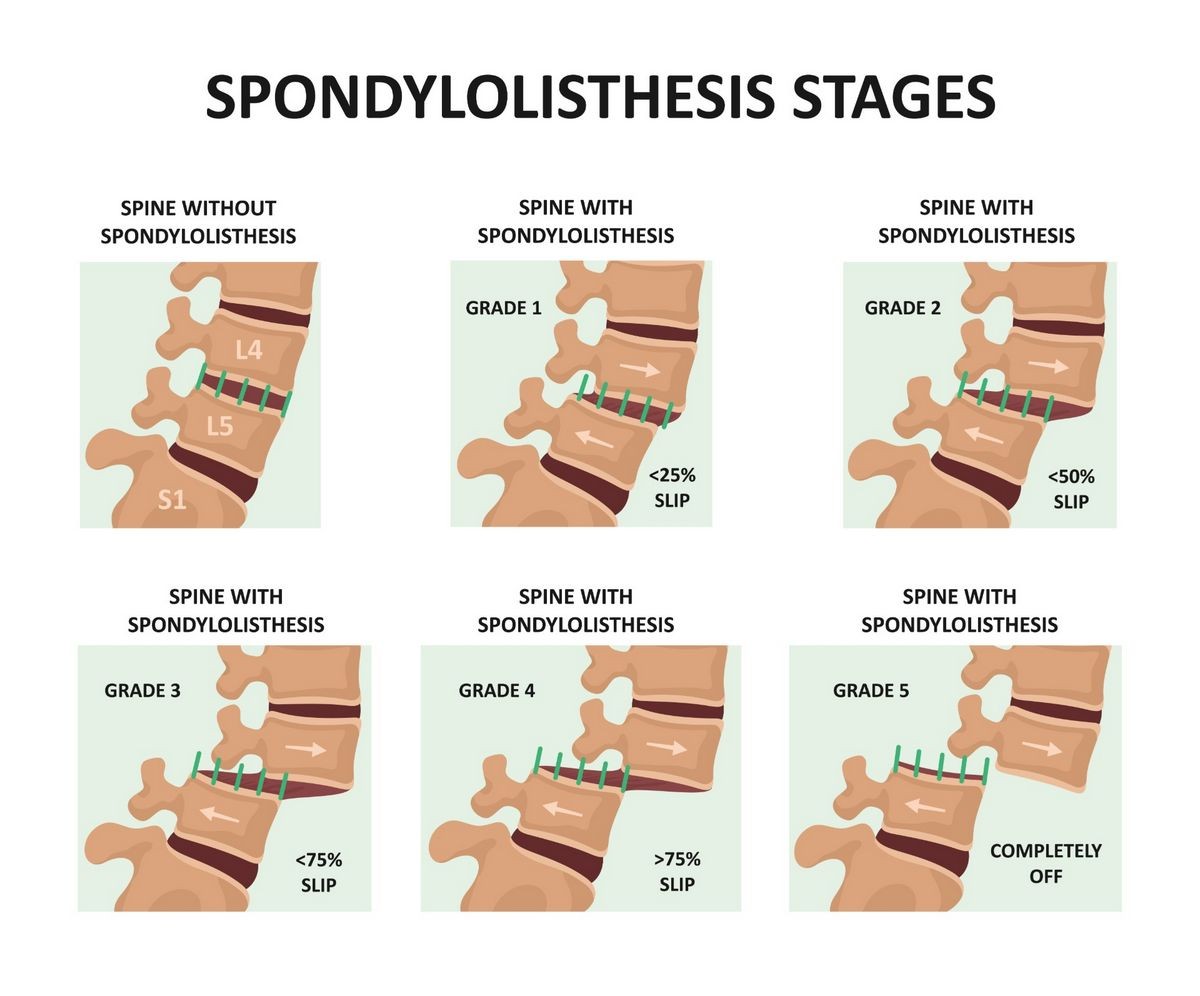
Contents
Spondylolisthesis
Spondylolisthesis is a condition of the spine where one vertebra slips forward or backward in relation to the next vertebra. Forward slippage is called anterolisthesis, while backward slippage is called retrolisthesis. Spondylolisthesis can cause spine deformity, narrowing of the spinal canal (central spinal stenosis), or compression of the exiting nerve roots (foraminal stenosis). It commonly occurs in the low back (lumbar spine) but can also happen in the mid to upper back (thoracic spine) and neck (cervical spine).
Causes of spondylolisthesis
There are five major types of lumbar spondylolisthesis.
- Dysplastic spondylolisthesis: Caused by a defect in the facet, part of the vertebra that allows slipping. It is a congenital condition.
- Isthmic spondylolisthesis: Caused by a defect in the pars interarticularis of the vertebra. If there is a defect without slipping, it is called spondylolysis. Common in athletes who do hyperextension motions, such as gymnasts and football linemen.
- Degenerative spondylolisthesis: Occurs due to arthritic changes in the vertebrae joints. More common in older patients.
- Traumatic spondylolisthesis: Caused by direct trauma or injury to the vertebrae. Can result from fractures in the pedicle, lamina, or facet joints.
- Pathologic spondylolisthesis: Caused by a defect in the bone due to abnormal bone, such as from a tumor.
Risk factors for spondylolisthesis
People with a family history of back problems are at a higher risk. Those born with a defect in the pars interarticularis bone (spondylolysis) are more likely to develop isthmic spondylolisthesis. Other risk factors include repetitive trauma or hyperextension of the lower back or lumbar spine. Athletes like gymnasts, weight lifters, and football linemen who put large forces on the spine during extension have an increased risk.
Symptoms of spondylolisthesis
The most common symptom is lower back pain, especially after exercise and with lumbar spine extension. Other symptoms include hamstring tightness, stiffness, decreased range of motion in the lower back, and worsened pain in the legs, thighs, and buttocks when standing. Nerve compression can cause pain, numbness, tingling, or weakness in the legs. Severe compression can lead to loss of bowel or bladder control (cauda equina syndrome).
Diagnosis and grading of spondylolisthesis
Spondylolisthesis is diagnosed using X-rays, CAT scans, or MRI scans. Treatment is provided by orthopedic surgeons, neurosurgeons specializing in the spine, physical medicine and rehabilitation doctors, neurologists, internists, primary-care providers, rheumatologists, chiropractors, and physical therapists.
The diagnosis is made through radiographs. A lateral X-ray can reveal if a vertebra has slipped forward compared to adjacent ones. Spondylolisthesis is graded based on the percentage of slip compared to the neighboring vertebra:
- Grade I: Up to 25% slip.
- Grade II: Between 26% and 50% slip.
- Grade III: Between 51% and 75% slip.
- Grade IV: Between 76% and 100% slip.
- Grade V (spondyloptosis): Complete vertebra displacement.
If there are leg symptoms, further studies may be needed. CT or MRI scans help identify nerve compression. PET scans can determine if the bone at the defect site is active.
Treatment and surgery for spondylolisthesis
The initial treatment involves rest, avoiding certain activities, and physical therapy to increase range of motion and strengthen the core abdominal muscles. Pain can be relieved with anti-inflammatory medications or epidural steroid injections. Hyperextension braces may benefit those with isthmic spondylolisthesis. Home remedies include ice, heat, and over-the-counter analgesics.
If symptoms persist, surgery may be an option. Repairing the defect in the vertebra or performing a decompression to create more space for nerve roots is based on the type of spondylolisthesis. Fusion may be performed, and physical therapy rehabilitation aids recovery.
Complications and prognosis of spondylolisthesis
Complications include chronic pain in the lower back or legs, as well as numbness, tingling, or weakness in the legs. Severe nerve compression causing bladder or bowel control problems is rare. Overall, the prognosis is good with most patients responding well to conservative treatment, and surgery helping alleviate leg symptoms and back pain through fusion.
Prevention of spondylolisthesis
Spondylolisthesis cannot be completely prevented. Certain activities like gymnastics, weight-lifting, and football increase stress on the vertebrae and the risk of developing spondylolisthesis.
By clicking Submit, I agree to the MedicineNet’s Terms & Conditions & Privacy Policy and understand that I may opt out of MedicineNet’s subscriptions at any time.


